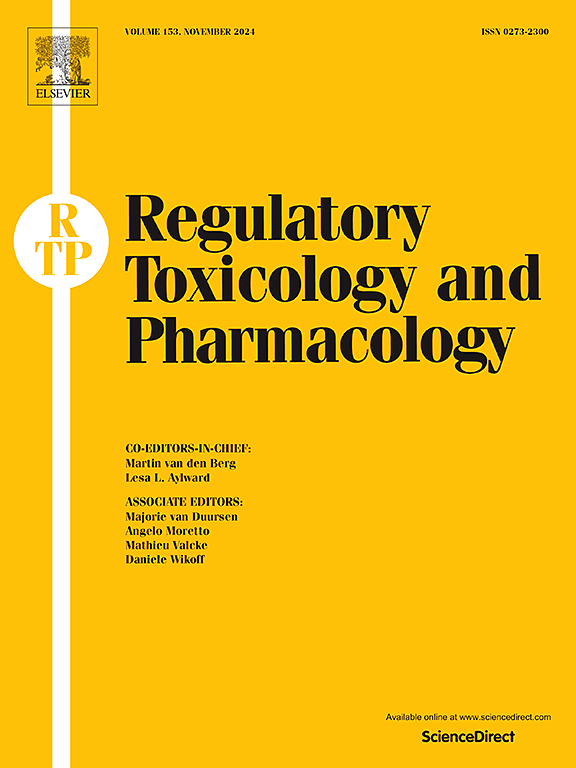刺果提取物对CCl4致肾损伤的保护作用。
IF 3.5
4区 医学
Q1 MEDICINE, LEGAL
引用次数: 0
摘要
本研究探讨了犬玫瑰(Rosa canina)醇果提取物对四氯化碳(CCl4)所致大鼠肾毒性的保护作用,并采用UPLC-ESI-MS/MS分析了其植物化学成分。将雄性Wistar大鼠分为5组,分别为对照组、犬黄芩提取物单独组、CCl4肾毒性组、CCl4加犬黄芩提取物组和CCl4加水飞蓟素组。UPLC-ESI-MS/MS共鉴定出15种化合物,主要为花青素、黄酮类化合物和番茄红素。用牛蒡提取物治疗可显著改善ccl4诱导的肾功能障碍,减轻氧化应激和炎症。HO-1(血红素加氧酶-1)和Nrf2(核因子-红细胞2相关因子2)mRNA在肾脏中的表达增加提示它们参与了保护机制。HO-1的抑制减弱了犬鼠对ccl4诱导的肾损伤的保护作用,强调了Nrf2/HO-1通路的重要性。为了进一步验证,进行了高通量分子对接分析。对接分析发现HO-1和Nrf2对Pelarginidin、Malvidin和Petunidin具有互作作用。在3种化合物中,pelargonidin对Nrf2和HO-1的结合分数最高,分别为-9.3kcal/mol和-7.7kcal/mol。综上所述,富含酚类物质的犬鼠黄提取物可能通过炎症和氧化应激抑制发挥肾保护作用,可能通过Nrf2/HO-1通路调节来对抗ccl4诱导的肾毒性。本文章由计算机程序翻译,如有差异,请以英文原文为准。
Protective effects of Rosa canina fruit extract against kidney damage induced by CCl4
The study explored the nephroprotective potential of Rosa canina (dog rose) ethanolic fruit extract against carbon tetrachloride (CCl4)-induced nephrotoxicity in rats, while also analyzing its phytochemical composition using UPLC-ESI-MS/MS. Male Wistar rats were allocated into five groups: control, R. canina extract alone, CCl4-induced nephrotoxicity, CCl4 with R. canina extract and CCl4 with silymarin. UPLC-ESI-MS/MS revealed 15 compounds in R. canina extract, predominantly anthocyanins, flavonoids, and lycopene. Treatment with R. canina extract significantly ameliorated CCl4-induced kidney dysfunction, abating oxidative stress and inflammation. Enhanced expression of HO-1 (heme oxygenase-1) and Nrf2 (nuclear factor erythroid 2-related factor 2) mRNA in the kidney suggested their involvement in protective mechanisms. Inhibition of HO-1 attenuated R. canina's protective effect against CCl4-induced kidney injury, underscoring the significance of the Nrf2/HO-1 pathway. For further validation, high throughput molecular docking analysis were performed. The docking analysis revealed the interaction between HO-1 and Nrf2 against Pelarginidin, Malvidin and Petunidin. Among all the three compounds, pelargonidin showed the highest binding score of −9.3 kcal/mol and −7.7 kcal/mol against Nrf2 and HO-1 respectively. In conclusion, R. canina extract, rich in phenolics, exhibited nephroprotective effects via inflammation and oxidative stress attenuation, potentially mediated through Nrf2/HO-1 pathway modulation against CCl4-induced nephrotoxicity.
求助全文
通过发布文献求助,成功后即可免费获取论文全文。
去求助
来源期刊
CiteScore
6.70
自引率
8.80%
发文量
147
审稿时长
58 days
期刊介绍:
Regulatory Toxicology and Pharmacology publishes peer reviewed articles that involve the generation, evaluation, and interpretation of experimental animal and human data that are of direct importance and relevance for regulatory authorities with respect to toxicological and pharmacological regulations in society. All peer-reviewed articles that are published should be devoted to improve the protection of human health and environment. Reviews and discussions are welcomed that address legal and/or regulatory decisions with respect to risk assessment and management of toxicological and pharmacological compounds on a scientific basis. It addresses an international readership of scientists, risk assessors and managers, and other professionals active in the field of human and environmental health.
Types of peer-reviewed articles published:
-Original research articles of relevance for regulatory aspects covering aspects including, but not limited to:
1.Factors influencing human sensitivity
2.Exposure science related to risk assessment
3.Alternative toxicological test methods
4.Frameworks for evaluation and integration of data in regulatory evaluations
5.Harmonization across regulatory agencies
6.Read-across methods and evaluations
-Contemporary Reviews on policy related Research issues
-Letters to the Editor
-Guest Editorials (by Invitation)

 求助内容:
求助内容: 应助结果提醒方式:
应助结果提醒方式:


